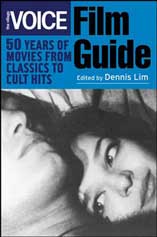|
Book Reviews: December 2011
 "The Village Voice Film Guide: 50 Years of Movies from Classics to Cult Hits"
"The Village Voice Film Guide: 50 Years of Movies from Classics to Cult Hits"
Edited by Dennis Lim
Cinephiles will relish Dennis Lim’s The Village Voice Film Guide: 50 Years of Movies from Classics to Cult Hits (Wiley, paperback, 336 pages, $16.95). Boasting 150 reviews, this stellar anthology also features an essay by noted cinema scholar and commentator J. Hoberman, “A History of Film Criticism at the Village Voice.” Smart, engaging, and provocative, this is film writing at its very finest.
Take, for example, the opening passages of four Village Voice reviews:
1. Andrew Sarris, August 6, 1970: “Once Upon a Time in the West begins with a gunfight at a train station shot as a low-angle panorama of Western wasteland psychology and ends after another shootout near a railroad in construction with a last shot of a high-angle panorama of Western expansionist history. With authenticated American actors like Henry Fonda, Jason Robards, Charles Bronson, Jack Elam, and Woody Strode, Once Upon a Time in the West is Sergio Leone’s most American Western, but it is still dominantly and paradoxically European in spirit, at one and the same time Christian and Marxist, despairing and exultant, nihilistic and regenerative.”
2. J. Hoberman, September 23, 1986: “Blue Velvet is a film of ecstatic creepiness—a stunning vindication for writer-director David Lynch. This is the first time since his midnight classic Eraserhead that Lynch has vented the full force of his sensibility, and the result is astonishing…Continually unpredictable, Blue Velvet is generically a teen coming-of-age film crossed with a noir. But Lynch is weirdest precisely when attempting to be most normal…Blue Velvet could be described as Archie and Veronica in the Twilight Zone or John Hughes meets Bunuel or The Hardy Boys on Mars, but no single phrase captures the film’s boldly alien perspective, its tenderness and disgust.”
3. Georgia Brown, June 27, 1995: “Like all of Todd Haynes’s work, Safe doesn’t make concessions to conventional expectations. It could be that people are put off by the ostensible subject, environmental illness—technically, multiple chemical sensitivity—or, as the movie puts it, a flat-out allergic reaction ‘to the twentieth century.’ One still and luminous California evening, stepping out of the family Mercedes into the family garage, Carol White (Julianne Moore) sneezes. “Bless you,’ replies her husband, Gregg (Xander Berkeley). God bless Carol White. By the end of Safe, the life of this San Fernando Valley housewife has been changed utterly.”
4. J. Hoberman, July 21, 1998: “There’s Something about Mary is less an asteroid sent hurtling toward the audience than a great gobby spitball. Duck if you’re squeamish. Proudly lowbrow, hopelessly incorrect, visually strident, and awash in bodily fluids, this third and funniest gross-out yuckfest by Peter and Bobby Farrelly goes a long way in establishing the auteurs of Dumb and Dumber and Kingpin as the conehead’s Coen Brothers.”
In sum, The Village Voice Film Guide deserves a place of prominence on every cineaste’s bookshelf. Two thumbs up!
Note: Cinema enthusiasts should also read Hoberman’s superb new study, An Army of Phantoms: American Movies and the Making of the Cold War (The New Press, 2011).
Review by Kirk Bane
|



 "The Village Voice Film Guide: 50 Years of Movies from Classics to Cult Hits"
"The Village Voice Film Guide: 50 Years of Movies from Classics to Cult Hits"